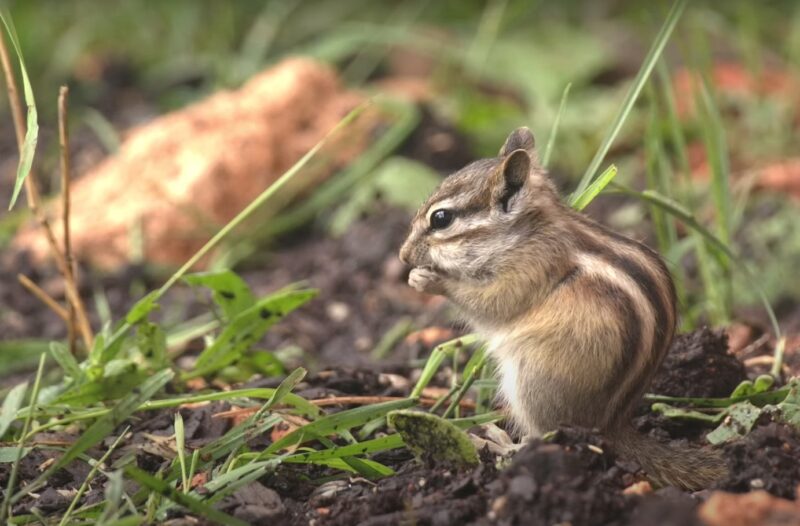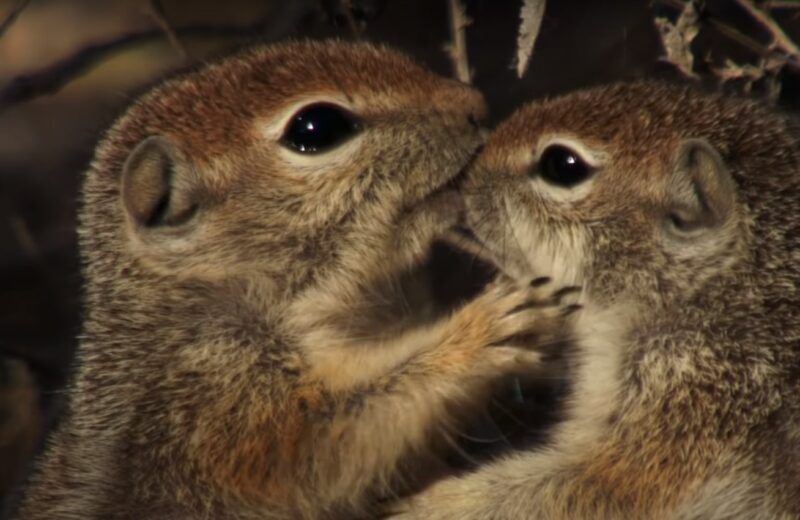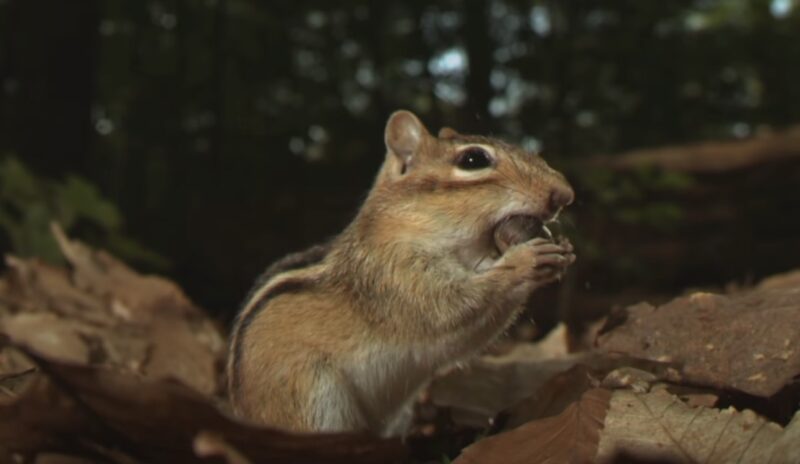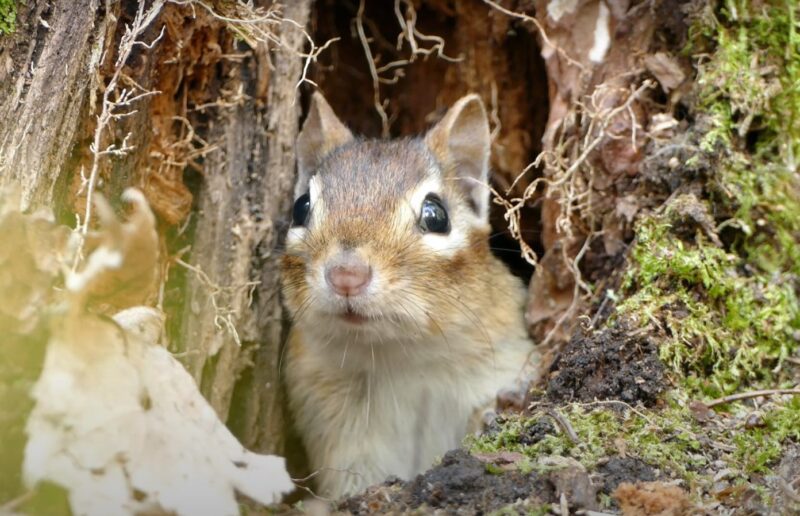Chipmunks, the small and striped rodents familiar to many, are a fascinating study in animal communication. Found across North America, Europe, and Asia, these creatures are not just adorable but also possess a complex system of vocalizations.
Moreover, the sounds they make enhance what we know about their ecology and behavior. It helps us recognize their presence and activities in our surroundings, especially in wooded areas where they are most active. That is why we would like to talk about them and their behavior in greater detail.
Types of Chipmunk Sounds

As is the case with practically any animal out there, chipmunks make a variety of sounds.
Warning Calls
Chipmunks are vigilant creatures, constantly on the lookout for danger. Their primary defense mechanism is their ability to produce sharp, high-pitched “chipping” sounds, serving as a warning call to others in the vicinity. These calls vary depending on the type of predator.
The “chip chip” sound is typically used to alert others of ground predators, while the “chuck chuck” sound signals threats from the air. This distinction in warning calls demonstrates the ability to differentiate between types of dangers and communicate effectively for survival.
Trills
In addition to warning calls, chipmunks use trills, particularly when evading predators. These trills, a rapid succession of notes, are often heard when chipmunks are in motion, darting away from a perceived threat. The trill serves as both an alarm to other chipmunks and possibly a mechanism to confuse or deter the predator.
Mating Calls
During the mating season, typically in late spring, they use specific vocalizations to attract mates. These mating calls, which resemble a mix of croaks and chirps, are especially prominent among male chipmunks. These sounds are not only crucial for reproduction but also add to the rich tapestry of sounds in habitats where chipmunks reside.
Communication Methods

When it comes to their communication methods, you will see that they are quite numerous as well.
Vocalizations
Chipmunks communicate extensively through various vocalizations. These include chirps, trills, squeaks, and even drumming sounds made with their teeth. Each type of sound serves a specific purpose, such as warning of danger, signaling a predator’s presence, or attracting a mate.
The variation in pitch and frequency of these sounds is remarkable, showcasing the complexity of chipmunk communication. High-pitched chirps and trills are typically used for immediate alerts, while lower-pitched chatter may be used for more general communication among chipmunks.
Scent Marking
Apart from vocal sounds, chipmunks also communicate through scent marking. They use their scent glands to mark their territory, conveying information about their presence and status to other chipmunks. This method of communication is especially important for establishing and maintaining territorial boundaries.
Different Purposes of Chirps
Chipmunks use different chirps for various purposes. Some chirps are designed to warn of immediate danger, while others are used to attract mates or communicate with fellow chipmunks. The ability to produce and interpret a range of sounds is crucial for the survival and social interaction in their natural habitat.
How Do They Act in Human Environments?

While chipmunks typically prefer outdoor habitats, especially underground burrows, they sometimes find their way into human homes. Unlike rats and mice, chipmunks are less destructive but can still carry parasites like ticks and fleas.
Interestingly, when chipmunks enter homes, they usually seek an exit, as their natural instinct is to stay close to the ground and in less exposed areas. Understanding their behavior in domestic settings is important for humane and effective management.
Distinction from Other Animals
Distinguishing chipmunk noises from those of other small animals, such as birds, and mice, can be a challenge. However, paying attention to the location of the sounds can be a helpful indicator. To be honest, seeing the difference in their diet and other animals is another challenge, like in the case of squirrels. They share similarities with many species.
Chipmunks, being burrowing animals, are often heard at ground level or in lower parts of structures, unlike some other animals that may nest in trees or higher elevations. Recognizing these nuances in sound and location aids in accurate identification and understanding of their behavior.
Residential Encounters and Solutions
In instances where chipmunks enter homes, homeowners often face the dilemma of how to deal with them. Although chipmunks are generally less inclined to stay indoors, their presence can still be problematic.
It’s important to understand that chipmunks are looking for a way out and humane removal methods should be considered. In cases of frequent encounters or infestations, professional wildlife removal services may be required to ensure safe and effective resolution.
The Observation

To truly appreciate and understand the variety of sounds they make, specific observation techniques can be employed. Listening for variations in pitch and frequency is one approach. This can help distinguish between different types of calls, such as warning signals or mating calls.
Additionally, using recording devices can aid in capturing these sounds for further study or enjoyment, especially in environments where they are abundant. Forest areas, particularly those with abundant ground cover and trees, are ideal for observing chipmunks and their vocalizations.
These natural habitats are where they are most active, especially during the day. By visiting these areas, enthusiasts can experience the full range of chipmunk sounds in their natural context. Observing chipmunks in these settings provides a deeper appreciation of their communication methods and their role in the ecosystem.
Importance of Professional Intervention
When encountering chipmunks or other wildlife in residential settings, it’s important to consider the need for professional intervention. While chipmunks are generally harmless, their presence in homes can be a sign of larger environmental or structural issues.
Professional wildlife removal services are equipped to handle such situations safely and humanely, ensuring that both the animals and homeowners are protected. These experts can also provide advice on preventing future intrusions, maintaining a balance between human and wildlife coexistence.
FAQs
What sounds are chipmunks afraid of?
Chipmunks are generally afraid of loud, unfamiliar noises. Sudden, high-pitched sounds or loud human activities can startle them and trigger a fear response.
Are chipmunks noisy?
Chipmunks can be quite vocal, especially when warning about danger or during mating season. However, their sounds are usually not loud or disruptive to human ears.
Is it bad to pick up a chipmunk?
Yes, it’s generally a bad idea to pick up a chipmunk. They are wild animals and can bite when frightened. Additionally, handling can stress the animal and potentially transmit diseases.
Are chipmunks good or bad?
Chipmunks are neither inherently good nor bad. They play a role in their ecosystem, such as seed dispersal and aeration of soil. However, they can be considered pests if they invade homes or gardens.
The Bottom Line
Complex chipmunk sounds offers a fascinating glimpse into the world of these small, yet complex creatures. You must admit that they are definitely fascinating creatures, which makes learning about them quite interesting.








